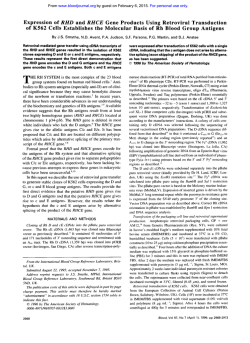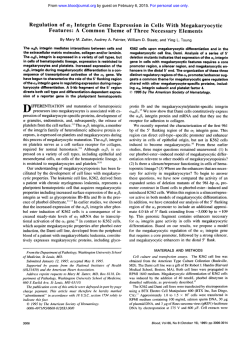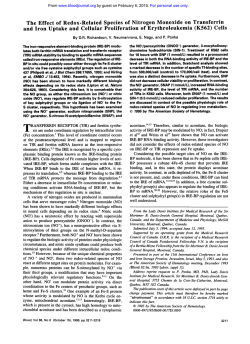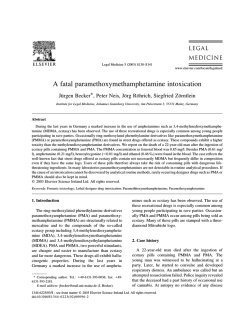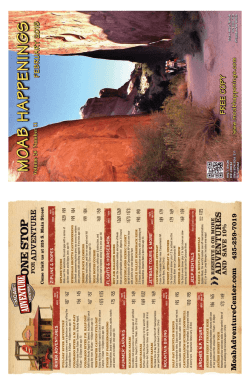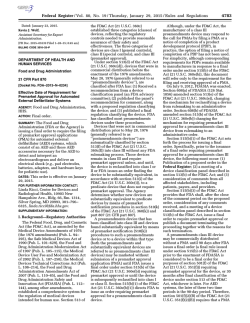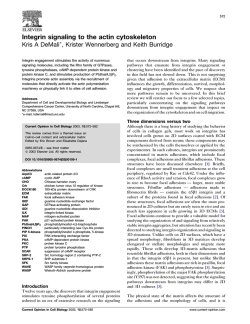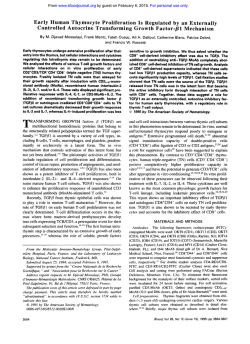
Transfected Leukocyte Integrin CDll b/CD18 (Mac-1
From www.bloodjournal.org by guest on February 6, 2015. For personal use only. Transfected Leukocyte Integrin C D l l b/CD18 (Mac-1) Mediates Phorbol Ester-Activated, Homotypic Cel1:Cell Adherence in the K562 Cell Line By Dennis D. Hickstein, Eduardo Grunvald, Grace Shumaker, Dianne M. Baker, Anthony L. Back, Lisa J. Embree, Ester Yee, and Katherine A. Gollahon The C D I 1b/CD18 leukocyte integrin molecule mediates diverse neutrophil adherence-related functions, including cell:cell and cell:extracellular matrix attachments. To study the individual role of this leukocyte integrin in cell adherence in hematopoietic cells, we expressed the C D I 1b/CD18 complex on the surface of K562 cells, a cell line derived from an individual with chronic myelogenous leukemia in blast crisis. We used an amphotrophic retroviral vector designated LCDI 8SN. harboring the complete coding sequence for the CD18 subunit, to transfer the CD18 cDNA into K562 cells and select stable cell lines. The C D I 1b subunit in the expression plasmid pREP4 was transfected into these K562/CD18 cells by electroporation and stable cell clones were selected. These K562 cells possessed RNA and intracellular protein for each subunit, and they expressed the CDI 1b/CD18 heterodimer on the cell surface. When CDI 1b/CD18 expressing K562 cells were stimulated with phorbol myristate acetate (50 ng/mL) for 2 4 to 48 hours, these K562 cells formed dense cekcell aggregates. This homotypic aggregation required both activation of the C D I 1 b/CD18 complex and the induction of the counter-receptor for C D I 1 b/CD18 on the conjugate cell. This cell line will (1) enable the structure-function relationships between cell activation and homotypic adherence to be assessed, (2) provide the opportunity to identify accessory molecules required for activation of the C D I 1 b/ CDI 8 complex, and (3)facilitate the identificationof novel ligands for the CDI 1b/CD18 complex. 0 1993 by The American Society of Hematology. T plished using a Not I/Acc I11 fragment at the 5’ end, an Acc III/Xho I fragment for the middle section, and an Xho I/Not I fragment at the 3’ end. The 4.1-kb CDl I b reconstruction contained the full-length coding sequence for CD 1 1b. The CD 1 1b cDNA with Not I ends was cloned into the Not I site of the expression vector PREP 4 (in vitrogen). The PREP 4/CDl lb antisense of “inverted” clone was constructed by cloning the CD 1 I b cDNA into the PREP 4 expression vector with the 3’ end of the CDI Ib cDNA located adjacent to the vector promoter. This construct served as a control. Transfer of the CD18 and C D l l b cDNA into K562. Supernatant from the LCDl8SN producing PA3 17 packaging cell line was used to infect K562 cells. After 24 hours of infection, the K562 cells were incubated in the presence of G4 18 ( 1 mg/mL). The G4 18-resistant K562 cells were used in all subsequent experiments. The PREP 4/CD1 l b plasmid was introduced into K562 cells, and K562 cells infected with LCD I8SN, by transfection. For the transfection, the K562 cells were electroporated using a BioRad Electroporation “Gene Pulser” (BioRad,Richmond, CA).Approximately 1 X lo7 cells were suspended in 0.5 mL of HEPES buffer (pH 7.5), placed in a 0.4 mL cuvette, and 100 pg of circular plasmid DNA was added. Plasmid DNA was prepared using equilibrium centrifugation in cesium chloride/ethidium bromide gradients.* K562 cells were electroporated at 250 V and 960 pF. Cells were HE NEUTROPHIL integrin complex CD 1 1b/CD 18 (Mac-1) has been shown to play a major role in both homotypic and heterotypic neutrophil adherence in vitro’,’ and in vivo.) Specifically, the adherence of activated neutrophils to each othe8 and to endothelial monolayers is inhibited by monoclonal antibodies (MoAbs) binding to the CD 1 1b/CD 18 complex.’ To facilitate understanding of the structural relationship between the CD 1 1b/CD 18 complex and hematopoietic cell adhesion, we transfected the cDNAs encoding the human CD1 l b and CD18 subunits into K562 cells. We selected K562 cells for these studies because (1) the cell line is derived from an individual with chronic myelogenous leukemia/blast crisis, and thus is an immature leukocyte cell line; (2) K562 cells do not express any of the leukocyte integrins, enabling CDl lb/CD18 expression to be studied in isolation; (3) K562 cells are susceptible to infection with retroviral vectors and to transfection by electroporation; (4)the promoters that result in high levels of expression in K562 cells are well characterized and ( 5 ) K562 cells are nonadherent.4 Previous studies of the leukocyte integrins have used transient transfections into adherent cell lines. Gene transfer of CD18 and C D l l b into K562 cells resulted in surface expression of the CD 1 1b/CD 18 complex. Treatment of the doubly transfected K562 cells with phorbo1 myristate acetate (PMA) induced homotypic cel1:cell adherence. The generation of this cell line expressing the CD 1 1b/CD 18 complex provides the opportunity to identify accessory molecules required for activation of the C D 1 1b/ CD 18 complex, and to identify novel ligands or counter-receptors for the CD 11b/CD 18 complex. MATERIALS AND METHODS Construction of expression vectors for CD18 and C D l l b . We used an amphotrophic retroviral vector, designated LCD 18SN, harboring the complete coding sequence for the CD 18 subunit, to transfer the CD18 cDNA into K562 cells. The construction of this vector and the packaging of this vector have been described.s.6 The full-length CD1 l b cDNA was reconstructed from overlapping cDNA for CDll b in X gt 1 1.7 This reconstruction was accomBlood. Vol82, No 8 (October 15). 1993: pp 2537-2545 From the Medical Research Service, Seattle VeteransAfairs Medical Center, Seattle; and the Department of Medicine, University of Washington School of Medicine, Seattle. Submitted December 28, 1992; accepted June 18, 1993. Supported by National Institutes of Health Grant No. DK 43530 (D.D.H.),the March of Dimes Birth Defects Foundation (D.D.H.), and the Veterans Afairs Career Development and Merit Review Programs (D.D.H.).A.L.B. is supported by a C.I.A.Awardfrom the National Institutes of Health (KO8 HL02637). Address reprint requests to Dennis D. Hickstein, MD, Medical Service (11I), Seattle VA Medical Center, 1660 S Columbian Way, Seattle, WA 98108. The publication costs of this article were defrayed in part by page charge payment. This article must therefore be hereby marked “advertisement” in accordance with 18 U.S.C.section 1734 solely to indicate this fact. 0 I993 by The American Society of Hematology. 0006-49 71/93/8208-0001$3.00/0 2537 From www.bloodjournal.org by guest on February 6, 2015. For personal use only. HICKSTEIN ET AL 2538 A The MoAbs used were anti-CD18 (MoAb 60.3), anti-CDIlb (MoAb 60.1 or MoAb OKMI), anti-CDI la (MoAb RR 3.1), antiCDI IC (MoAb LeuMS), and anti-murine leukemia virus envelope protein (MoAb 9E8). In flow cytometry, an increment of 20 U on the log scale on the abscissa represents a doubling of fluorescence promoter 5.4 kb intensity. In selected studies, PMA was incubated with cell populations at a concentration of 50 ng/mL for 48 hours before flow cytometry analysis. Western blotting. Cell lysates were generated from K562 cells, K562 cells infected with the retroviral construct LCDl8SN, K562 pREP4/CDllb cells infected with LCDl8SN and transfected with the PREP expression vector containing the CDI Ib cDNA, and normal polymorphonuclear leukocytes (PMN). The individual lysates were subjected to gel electrophoresis on a 7% acrylamide reducing gel, transblotted to nitrocellulose, and reacted with the anti-CD18 or antLCD1 1b rabbit polyclonal antibodies. Blotting patterns were esPREP4 tablished by exposure to the chromogen 5-bromo-4-chloro-3-indolyl-phosphate/nitro blue tetrazolium. In previous studies, we have described the monospecific nature of the anti-CD 18 antibodysa6and the anti-CDI Ib a n t i b ~ d y . ~ SV-40 Northern blotting. Total cellular RNA was isolated from K562 Ori cells, LCDl8SN infected K562 cells, LCDISSN + pREP4/CDI Ib K562 cells, and LCD18SN + PREP 4/CD1 Ib antisense or "inFig 1. Vectors used to express the CD18 and C D l l b subunits. verted" clone, using the guanidine HCl method." In the Northern (A) The amphotrophic retroviral vector LCDl8SN was created by cloning the CD18 cDNA into the Hpa I site of MSN. (B) pREP4/ blotting studies, 10 pg of total RNA was electrophoresed on a formCDl 1b was created by cloning the full-length C D l l b cDNA into aldehyde-agarose gel, transferred to nitrocellulose, and hybridized the Not I site in the polylinker of the episomal expression vector to a nick-translated "P-labeled 1.8-kb cDNA corresponding to the pREP4. RSV LTR indicates the Rous sarcoma virus LTR. CD18 subunit,12a 0.7-kb cDNA corresponding to the CDl Ib subunit,' or to the 2-kb chick @-actinPst I cDNA fragment.I3 Analysis of CD1I b/CDl&mediated cel1:cell adhesion. To assess the ability of the reassembled CDl 1b/CD18 heterodimer on placed in Dulbecco's modified Eagle's medium (DMEM) after elecK562 cells to mediate cel1:cell adhesion, K562 cells, K562 cells troporation and incubated at 37°C in 5%C02/95%air in the contininfected with LCDlSSN, K562 cells transfected with the CDI l b uous presence of hygromycin at 100 pg/mL. Individual hygromycDNA, and K562 cells expressing the CDI lbjCD18 complex were cin-resistant CDI I b clones were isolated by limiting dilution. incubated in the presence of PMA (50 ng/mL) for 4, 24, and 48 Immunofluorescence flow cytometry. Individual cell populahours. At the end of the incubation period, the cell populations tions of K562 cells resistant to (3418 and hygromycin were anawere photographed using a Nikon inverted microscope (Nikon lyzed for surface expression of the CD1 I/CD18 leukocyte integrin Corp, Melville, NY). Adhesion of K562 cells was scored according heterodimers using subunit specific MoAbs and indirect immunofluorescence followed by flow cytometry as described p r e v i o u ~ l y . ~ ~ to ~ ~the extent of cluster formation or aggregation in response to LCD18SN B I K562 K56BCDlB K562JCD18 +CDllb K56BCD18 +CDllb flnverted) CDlla Fig 2. Immunofluorescence flow cytometry of K562 cells and human neutrophils. The cell populations designated at the top consist of (1) K562 cells, (2) K562 cells infected with the retroviral construct LCD18SN. (3)K562 cells infected with CDllb (MAb60.1) z P 2 NeulroDhil CDllb (MAbOKMI) CDllc CDl0 Relative fluorescence intensity (log scale) LCDl8SN and transfected with the C D l l b cDNA in the expression vector pREP4, (4) K562 cells infected with LCDl8SN and transfected with the C D l l b cDNA in the antisense orientation in the expression vector pREP4, and ( 5 )normal human neutrophils. The cell populations designated at the top were incubated with a control MoAb 9E8 (---) or with an MoAb specific for the individual C D l l or After incubation with the CD18 subunits (-). MoAbs, cells were incubated with a fluoresceinated sheep anti-mouse antibody and analyzed by flow cytometry. Relative fluorescence intensity is shown on the abscissa on a log scale from 0 to 200, where each mark represents a fourfold increase in fluorescence intensity. Cell number appears on the ordinate. From www.bloodjournal.org by guest on February 6, 2015. For personal use only. 2539 TRANSFECTED LEUKOCYTE INTEGRIN C D l l B/CD18 K562 K562/CD18+ CD11 b Nikon fluorescent microscope was used to capture images of the samples. In addition, photographs were taken in the plates with a Nikon inverted fluorescent microscope using Ektachrome ASA 400 color film. Filters were the G2 and B2 filters from Nikon. RESULTS Relative flourescsnce intensity (log scale) Fig 3. Analysis of surface expressionof the C D l l b subunit. Indirect immunofluorescence (as in Fig 1) was used to determine surface expression of the C D l l b subunit in K562 cells (top left panel), K 5 6 2 cells infected with LCD18SN and transfected with PREP 4/ C D l l b (top right panel), and two different clones of K562 cells transfected with PREP 4/CD11 b alone. The K562 cells infected with LCDl8SN represent clones selected in G418, and the K562 cells transfected with pREP4ICDll b were selected in hygromycin. as described in the Materials and Methods. Each mark on the relative fluorescence intensity scale on the abscissa represents a sixfold increase in fluorescence intensity. PMA. The degree of aggregation was scored with scores ranging from 0 to 5+, where 0 indicated that essentially no cells were in clusters, 1+ indicates less than 10%of cells in aggregates, 2+ indicates less than 50% of cells in aggregates, 3+ indicates up to 30%of cells in loose clusters, 4+ indicatesup to 100%of cells in aggregates, and 5+ indicates up to 100%of cells in large, very compact aggregate~.’~,’~ The blocking MoAbs used in the adhesion assays consist of MoAb MHM 23 (anti-CDl8), MoAb H52 (antLCD18), MoAb 904 (anti-CD1 Ib), MoAb 60.1 (anti-CD11b), and MoAb OKMl (antiCDI Ib). All MoAbs were used at saturating concentrations. The anti-CD1 Ib MoAb LPM19c (Dako Corp, Carpintena, CA) was used in separate blocking experiments (see Fig 7).16 Two-color analysis of homotypic adherence of K562 cells. K562 cells or K562/CD18 + CDI Ib cells were harvested and resuspended at IO’ cells/mL. Cationic membrane probes from Molecular Probes (Eugene, OR) were used to mark the two cell lines.” These reagents were DiO, octadecyl C I8 oxacarbocyanines (green), and DiI, octadecyl C18 indocarbocyanines (red). These reagents were dissolved in dimethylsulfoxide (DMSO) at 100 mg/mL and the K562 cells were stained with DiO (green) and the K562/CDl8 + CDI I b cells (labeledas doubles)were stained with DiI (red) ( 100 pg/mL at 37°C for 2 hours). The cells were then washed and resuspended in media at 5 X I05/mL. One aliquot of each of the two cell populations was treated with PMA at a concentration of I O ng/mL (these cells are labeled as + in Fig 8). A second aliquot of each cell population was not treated with PMA (these cells are labeled as - in Fig 8). After 48 hours of incubation, the following 1:1 mixtures of cells were made in a 6-well plate: K562 (-) and doubles (+); K562 (+) and doubles (-); and K562 (+) and doubles (+). Wet mounts were made of the samples and a Nikon video camera attached to a Vectors used to transduce CD18 and CDllb into K562 cells. Two different vectors using two different methods of gene transfer were used to introduce the CD 18 and CD 1 1b cDNAs into K562 cells. An amphotrophic retroviral vector containing the CD18 subunit (LCD18SN) was used to transduce the CD 18 subunit into K562 cells (Fig 1A). In this vector, the CD18 subunit is expressed from the Moloney long terminal repeat (LTR).’*The CD11b subunit wasintroduced into K562 cells using the pREP4 expression plasmid (Fig 1B). This vector contains the Epstein-Barr virus (EBV) origin of replication and replicates episomally. It also contains a hygromycin-selectable marker. In this construct, the CDI lb cDNA is expressed from the Rous sarcoma virus promoter. Surface expression of leukocyte integrins on K562 cells. Expression ofthe individual CDI 1 and the common CD 18 subunit was analyzed using subunit-specific MoAb and indirect immunofluorescence followed by flow cytometry (Fig 2). None of the leukocyte integrins are expressed on K562 cells or K562 cells transduced with the CD18 subunit alone (Fig 2, columns 1 and 2). However, both CD1 l b and CD 18 are expressed on the surface of K562 cells transduced with cDNAs for both CD18 and CD1 lb (Fig 2, column 3). Introduction of the CDI Ib subunit in the antisense orientation (CD1 lb inverted) into CDl 8-expressing K562 cells failed to result in surface expression of the CDI Ib/CD18 heterodimer (Fig 2, column 4). Levels of expression of CD 1 1b/CD 18 on human neutrophils were more uniform than the levels present on the CD 1 1b/CDIg-transduced K562 cells, consistent with the variability in copy number of CDl Ib introduced into K562 cells using the episomal based vector pREP4. Human neutrophils contain CDl la/ CD 18, CD 1 1b/CD 18, and CD 1 1c/CD 18; in contrast, the CDI lb + CD18 transfected K562 cells express only CDI lb/CD18. Table 1. Adherence of Transfected K 5 6 2 Cells in Response to PMA K562 K562/CD 18 K562/CD11 b (low) K562/CD1 l b (high) K562/CD18 CD1 l b + + + - PMA + PMA PMA +Anti-CD1 1b PMA +Anti-CDlB 010 010 010 +1/+1 +2/+1 +1/+2 +2/+1 +4/+3 +1/+1 +2/+1 +1/+2 +2/+1 +4/+3 +1/+1 011 111 +2/+2 +1/+2 +2/+1 +4/+3 K562 cells were incubated without (-PMA) or with PMA (+PMA) at 5 0 ng/mL for 48 hours. The MoAbs used were anti-CD18 (MoAb MHM 23 and MoAb H52) and anti-CD1 l b (MoAb 904, MoAb 60.1, and MoAb OKM1). These MoAbs were added to the PMA-treated cells as described in the Materials and Methods. The scoring system for aggregation ranges from 0 (no aggregation) to 5+ (100% of cells in large, compact aggregates), as described in the Materials and Methods. From www.bloodjournal.org by guest on February 6, 2015. For personal use only. HICKSTEIN ET AL 2540 A B aD c 0 z 0 \ V N N u) W v) Y) Y Y ez+ , 2 E - 200 KD e- 1 2 3 4 - 116 KD - 97KD - 66KD 1 2 3 4 Fig 4. Westem blotting studies of K562 cells and m a l PMN. Cell lysates were obtained from K562 cells (lane 1). K562 cells infected with the LCD18SN retroviral ~ ~ n s t (lane ~ c t2), K562 cells infected with the LCDlSSN retroviral construct and transfected with the PREP-CD11b vector (lane 3). and normal PMN (lane 4).The individual cell lysates were separated by sodium dodecyl sulfate-polyactylamide gel electrophoresis, transferred to nitrocellulose, and reacted with an anti-CD18 rabbit polyclonal antibody (A) or an anti-CD11 b rabbit polyclonal antibody (E) followed by an alkaline phosphatase-linked antirabbit antibody and chromogen, as described in the Materials and Methods. Molecular weight standards appear on the right. Arrows indicate the size of the PMN CD18 and CD11 b subunit. The individual CDI I and CD18 subunits appear to require heterodimer formation for efficient surface expression.I9To evaluate the ability of individual CDI I b subunits to become surfaceexpressed independent of CD18. we compared the surface expression of CD I I b on K562 cells transduced with CDI I b alone with that of K562 cells transduced with both subunits (Fig 3). Efficient surface expression of CDI Ib required CD18 (Fig 3, upper right panel). However, selected clones of K567 cells transduced with CD 1 I b alone were capable of surface expression of CD I I b in the absence of CDI 8 (Fig 3. lower right panel). These two CDI Ib-expressingclones were used in functional studies to assess homotypic aggregation (Table I). In those studies. the cell populations are labeled K562/CDI Ikl (low) and K562/CD I I k 2 (high). ,fnulj*.visol'inirucidlrrlar proicin,fi)rCDI Ih and CDI8 in KS62 ccll.~. To analyze the molecular weights of the CDI Ib and CD18 subunit in K562 cells. Western blotting studies were performed. The CD18 subunit in K562 cells had an approximate molecular weight of 90 Kd (Fig 4A. lane 2). The CD18 subunit is not processed to the higher molecular weight 100-Kd membraneexpressed form in the absence ofCD1 I b. consistent with previous~tudies.'~ When CDI I b is introduced. approximately 25% of the CD18 is processed to a higher molecular weight form (Fig 4A. lane 3). indicating that heterodimer formation is important for processing. Despite the increase in molecular weight of CD18 in thepresenceofCD1 Ib, theCD18 protein in K562 never reaches the size of the membranecxpressed form of CD18 prescnt in neutrophils. The CDI Ib subunit in K562 cells appears to be the same molecular weight as that of the CDI Ib subunit in human PMN (Fig 4R. compare lanes 3 and 4). Ana/wis orCDl Ih and CD18 mRNA in K562 cell.^. The levels and sizes of CD18 and CDI I b mRNA in the transduced K562 cell clones were approximately equal on Northern blotting(Fig 5). This indicated that both the retroviral vector used to introduce CD18 and the episomal pREP4/CDI Ib resulted in production of their respective mRNAs of appropriate size. These results are consistent with previous studies showing the utility of the promoters used in these constructs to express heterologous genes in hematopoietic cells. R c y m s c * d K M 2 cells io P.V.4. To assess the effect of PMA on the surface expression of the leukocyte integrins. flow cytometry studies were performed (Table 2). There was no increase of surface expression of the CD 1 I b/CD I8 complex on the CDI 1 b/CDI %expressing K562 cells in response to PMA. Firnctii)nnl activiiy (?ftiii~ CDI Ih/CD18 iicicrodimcr.The transfected K562 cells were examined for their ability to mediate cell:ccll adherence reactions in response to PMA. K562 cells. K562 cells infected with LCDl 8SN, and K562 cells expressing high levels of surface CDI I b formed a few small clumps in response to PMA (Fig 6. right-hand column). In contrast. K562 cells expressing surface CDI Ib/ CD I8 formed dense aggregates in response to exposure to PMA for 48 hours (Fig 6.bottom right panel). To quantitate the homotypic cell:cell aggregation. cell aggregates were scored according to the amount ofclumping. asdcscribed in the Materials and Methods. The K562 cells expressing the CDI I b/CDI 8 heterodimer aggregated to a much greater extent than the K562 cells transduced with either subunit alone (Table I). MoAb M H M 23 and MoAb H52 directed against the CDI 8 subunit. and MoAb 904. MoAb 60.1. and MoAb OKM I directed against the CDI I b subunit failed to block this homotypic adherence (Table I). Only MoAb LPM 19c. directed against the CDI I b subunit. blocked homotypic aggregation (Fig 7). MoAb LPM I9c was not used in the experiments shown in Table I. Without MoAb LPM I9c. the K562 cells expressing CD I 1 b/CD I8 showed 3+ to 4+ aggregation in response to PMA. whereas the aggregation was reduced to 2+ in the presence of LPM19c. The MoAb R6.5. directed against domain 3 of intercellular adhesion molecule-I (ICAM-I ). also failed to block this homotypic adhesion (data not shown).'" From www.bloodjournal.org by guest on February 6, 2015. For personal use only. TRANSFECTED LEUKOCYTE INTEGRIN CD1 lelCD18 2541 6 6 00 + + C D l lb CD18 Kb DISCUSSION Kb 4.7 3.4 - - I 1 2 3 4 Actin Kb Actin I tion (Fig 8, top panels). When the doubles (red)were treated with PMA and added to untreated K562 cells (green), the clumps that formed werc entirely red (Fig 8. middle panels). This indicated that the untreated K562 cellswere not participating in the aggregates, and it suggested that a ligand for CDI Ib/CD18 needed to be induced on the K562 cells by PMA. When both cell populations were treated with PMA. the aggregates consisted of both red and green cells. indicating that both activating the CDI I b/CD18 complex and inducing a ligand for CDI 1 b/CDI 8 were required for the aggregation (Fig 8, bottom panels). Kb 2- I 1 2 3 4 Fig 5. Northem blotting of K562 cells. Total cellular RNA (20 pg/lane) was extracted from the designated cells, separated on formaldehyde-agarose gels, transferred to nitrocellulose, and sequentially hybridized to "P-labeled cDNA probes correspondingto CDl 1b, CD18, and B-actin. The lanes are K562 cells (lane 1). K562 cells infected with the LCDl8SN retroviral construct (lane2). K562 cells infected with the LCDl8SN retroviral construct and transfected with the PREP-CD11b vector (lane 3).and K562 cells infected with the LCDl8SN retroviral construct and transfected with the pREP4 expression vector harboring the C D l l b cDNA in the antisense orientation (inverted) (lane4). The size of the transcripts are indicated on the left. T~tw-cokor staininx of nontransclttccd and transdtrccd KS62 cd1.s. To address the question of whether PMA was "activating" the CDI I b/CD18 complex to mediate homotypic adhesion. or whether PMA was inducing a ligand or counter-receptor for the CDI I b/CDI 8 complex. two-color studies were performed using K562 cells and K562 cells transduced with both subunits (termed doubles). Cells were incubated in the absence of PMA (-) or in the presence of PMA (+), and then the labeled cells were mixed and assessed. These results are shown (Fig 8). When K562 cells (green)were treated with PMA and incubated with doubles (red) that were untreated. the few small clumps that formed were green, suggesting that the CDI Ib/CD18 complex needed to be "activated" by PMA to mediate cell aggrega- The inflammatory response requires the recruitment of circulating leukocytes to the site of infection. The recruitment of neutrophils or P M N requires that the neutrophil possess the ability to participate in a variety ofadherence-related functions. To participate in these functions. neutrophils use a number of different adhesion molecules.2"'' The leukocyte integrin CDI I b/CD18 adhesion molecule playsa major role in mediating these adherence functions. The evidence for the role of CDI 1 b/CD18 in neutrophil adherence is twofold. MoAbs directed against the CDI I b/ CD18 complex block ( I ) the binding of C3bicoated particles to the neutrophil.24(2) the adherence of neutrophils to (3) homotypic neutrophil aggregation.' endothelial and (4) neutrophil adherence in vivo.-' Secondly. children born with genetic defects in CDI 8 that prevent surface expression oftheCD1 I/CD18 complexsuffersevererecurrent bacterial infections because of the inability of leukocytes to migrate to the site of infection.'" There are two special features ofCDl I b/CDI %mediated adherence. First. there is evidence that the epitop on CDI Ib/CD18 that binds C3bi is distinct from the epitope that binds to the endothelial celL2' Second. adhesion mediated by CDI I b/CD18 requires "activation" of the integrin heterodimer. Activation can be accomplished experimentally by phorbol esters. or by various inflammatory mediators (ie. tumor necrosis factor. C5a. f-met-leu-phe). Table 2. Expression of Leukocyte lntegrins on K562 Cells in Response to PMA K562 cells K562 cells + PMA K562/CD18 K562/CD18 + PMA K562fCD18fCDllb K562/CD18/CD1 l b + PMA K562/CD18/CDll b (inverted) K562/CD18/CDll b (inverted) + PMA Control CDt8 CDttb 3.6 7.2 5.4 15.3 3.8 6.9 6.2 14.5 33.1 30.3 5.5 6.9 5.0 7.1 6.2 15.9 81.5 53.1 7.2 6.3 3.0 9.2 4.6 7.3 Each cell population was incubated with an irrelevant first antibody (control), an anti-CD18 MoAb. or an anti-CD11b MoAb followed by a fluorescein isothiocyanate-linked sheep antimouse antibody and analyzed by flow cytometry. Results are expressed as the percentage of cells above the backgroundfluorescence obtained using only a fluorescein-linkedsecond antibody. Cells were stimulated with 50 ng/mL PMA for 48 hours. From www.bloodjournal.org by guest on February 6, 2015. For personal use only. HICKSTEIN ET AL 2542 + PMA K562 K562/ CDllb Fig 6. Adhesion of K562 cells in response to PMA. K562 cells. K562 infected with the LCDl8SN retroviral construct, K562 cells transfected with pREP4/CDllb, and K562 cells infected with the LCDl8SN retroviral construct and transfectedwith pREP4/CDll b, were incubated in the absence (left-hand panels) or presence (righthand panels) of PMA at 5 0 ng/mL for 4 8 hours. At the end of the incubation period, the cells were photographed using a Nikon inverted microscope and scored for aggregation as described in the Materials and Methods. K562/ CD18 CDllb Stimulation of neutrophils with chemoattractants is required to activate binding of these integrins to ICAM-I .25*27 Stimulation of neutrophil integrin avidity is a rapid response that occurs within minutes. and does not require an increase in integrin surface expression.’* Studies in which other integrins have been transfected into heterologous cells provide a useful background for interpreting our results. Intracellular signals have been shown to influence the functional activity of the CDI Ia/CD18 complex. Lymphoid cell lines expressing CDI la/CD18 do not spontaneously aggregate in culture: however. treatment with phorbol esters induces a rapid aggregation of these cell^.'^ Phorbol ester stimulation is not accompanied by an increase in surface expression of CDI la/CD18.” Instead, exposure to phorbol esters convertsCDI Ia/CDI 8 to a highaffinity state.29In addition to treatment with agents that activate intracellular protein kinase C, the adhesion of the leukocyte integrin CDI Ia/CD18 (LFA-I) for ICAM-I substrates is enhanced by cross-linking of the T-cell receptor.” These observations support the idea that signals from the cytosol lead to changes in the extracellular domain of CDI la/CD18, and these changes result in a CDI Ia/CDI8 complex with an increased adherence for ICAM-I. When the CDI la and CDI 8 subunits were cotransfected into Coscells. the CDI 1a/CD18 heterodimer wasconstitui- tively active and not functionally regulated. Although Cos cells expressing the dimer bound to ICAM-I. these cells did not respond to PMA with a further increase in affinity for ICAM-I In addition. the CD18 subunit was absolutely required for expression of the CDI la subunit in Cos cells.”’ These studies indicated that the CDI Ia/CD18 complex on fibroblastoid cells is not functionally regulated. Upon transfection into leukocyte adherence deficiency (LAD) ERV B-lymphoblastoid cell lines, the transfected CD18 subunit forms a heterodimer with the endogenous CDI la subunit. and this complex can be activated by PMA to mediate binding to ICAM-I.” This binding activity is modulated by cytoplasmic domain sequences. Studies of the platelet integrin Ilb/llla also provide insight into theCDI I b/CDI 8 leukocyte integrin. The Ilb/llla complex binds to soluble fibrinogen only after cellular stimulation.’* In llb/llla. this affinity change is due to alterations in the conformation of the receptor.” When Chinese hampster ovary (CHO) cell lines were cotransfected with Ilb/llla in expression vectors, surface expression of the heterodimer was achieved. The Ilb/llla-transfected cells did not bind soluble fibrinogen unles the Ilb/llla complex was activated using an MoAb that binds to the extracellular domain of llla and “activates” the receptor.-” When a Ilb subunit containing a deletion of the cytoplasmic domain was .’””’ From www.bloodjournal.org by guest on February 6, 2015. For personal use only. 2543 TRANSFECTED LEUKOCYTE INTEGRIN CD11B/CD18 K562/CD18 - Fig 7. MoAb LPM19c blocking studies. K562 cells expressing the CD11 b/CD18 heterodimer were unstimulated (top panel), stimulated with PMA for 48 hours in the absence of LPMl9c (middle panel). and stimulated with PMA in the presence of MoAb LPMl9c (lower panel). At the end of the incubation period, the cells were photographed as described in Fig 6. The aggregation of the C D l l b/CD18-expressing K562 cells scored 3 to in 4 in the absence of MoAb LPMl9c and 2 the presence of MoAb LPMl9c. + CDllb + C D l lb PMA K562/CD18 + + PMA K5621CD18 + CD1 1 b + PMA + LPM19c + + transfected with Illa. the resulting heterodimer was constituitively active. These results indicate that sequences in the cytoplasmic domain of Ilb control the affinity state of Ilb/ Illa. It is postulated that these sequences bind to an intracellular molecule that maintains the receptor in a low-affinity conformation. To characterize the role of the CDI I b/CDI 8 complex in mediating adherence reactivity. we used gene transfer to reassemble the two subunits of this heterodimer on K562 cells.4We selected the KS62 cell line because it is a nonadherent, immature leukocyte cell line that lacks all members of the leukocyte integrin family. In addition, KS62 cells are susceptible to retroviral-mediatedgene transduction as well as transfection by electroporation. We aswssed the KS62 cells after gene transfer and showed the presence of RNA, intracellular protein, and surface expression of the CDI I b and CD18 subunits. We then showed that this heterodimer enabled K562 cells to aggregate in response to PMA. However. aggregation required the addition of PMA as an agonist. and the homotypic cell:cell adhesion required 24 to 48 hours for maximum effect. The activity of the CDI I b/CDI 8 complex on K562 cells requires some explanation. First. the complex does enable K562 cells to display homotypic cell:cell adherence in response to PMA. The rapid response to PMA may require additional cytosolic factors that are not present in KS62 cells as a result of the relative immaturity of these cells. Instead. these accessory molecules may need to be induced by PMA. In previous studies using transient transfection assays,Coscellscotransfectcdwith CDI I b/CDI 8 expressed the heterodimer on the surface ofapproximately 43%ofthe cells: however. these transfected cells did not interact with ICAM-1.” One explanation for thisobservation is that both K562 and Cos cells lack factors required to “activate” the CDI 1 b/CDI 8 complex to mediate adherence. For example. the FcRdllA cDNA mediated a phagocytic response when transfected into P388DI (a mouse macrophage cell line). but not when transfected into CHO cells.34Thus, the FcRdllA-mediated phagocytic response, and the associated calcium flux. require macrophage signaling machinery. which is not present in fibroblasts. Our transfection studies of CDI Ib/CD18 in KS62 cells are consistent with parallel studies using the integrins CDI Ia/CD18 and platelet Ilb/ llla in that transfection of both subunits reconstitutes surfaceexpression. but activation ofthe integrin is required for functional adherence. The observation that homotypic adherence of the transfected KS62 cells requires 2 4 to 48 hours for maximum effect, unlike neutrophil aggregation. which occurs within minutes after the addition of PMA, suggests that PMA may be acting by inducing a ligand on the conjugate cell. The leukocyte integrin CDI Ib/CD18 binds to the third amino terminal Ig-like domain of ICAM-I. and this binding a p pears to be influenced by the extent of glycosylation on the ICAM-I m01ecuIc.~~ Of note. this binding is of low affinity. The ICAM-I molecule was not upregulated on K562 cells From www.bloodjournal.org by guest on February 6, 2015. For personal use only. HICKSTEIN ET AL 2544 Phase Doubles (red) K562 (green) Doubles hellow) K562 + PMA Doubles - P M A K562 - PMA Doubles + PMA + Fig 8. Two-color analysis of homotypic aggregationof K562 cells. K562 cells were stained with DiO (green) and K562/CD18 CD1 cells (labeledas doubles) were stained with Dil (red) at 37°C for 2 hours. The cells were then washed, resuspended in media, and treai with PMA ( ) or left untreated ( ). After 48 hours of incubation,the following 1:1 mixtures of cells were made in a 6-well plate: K562 ( and doubles ( 1; K562 ( ) and doubles ( -); and K562 ( + ) and doubles (+ ). Wet mounts were made of the samples and a Sony Trinii video camera attached to a Nikon fluorescent microscope was used to capture images of the samples. The left-hand column represei phase microscopy, the middle panel images the red cells, and the right-hand panel images the green cells. + + + - using PMA (data not shown). Because the CD 1 1b/CD I8 complex does not bind to ICAM-2:7 an endothelial molecule related to ICAM-1:' and ICAM-3 is not present on K562 cells, a novel counter-receptor may be mediating this adhe~ion.~',~~ In the MoAb blocking studies, only MoAb LPM19c blocked the PMA-induced aggregation of the CD 1I/CD 18expressing K562 cells. MoAb LPM19c, which binds to the I domain ofCD1 Ib, blocked neutrophil awegation in a previous study.37A number ofother MoAbs, which bind to the I domain of CD11b and reduce binding to fibrinogen, ICAM-1, and iC3b, only minimally influence neutrophil homotypic adhe~ion.'~ These differences in the patterns of MoAb inhibition indicate the presence of several different functional domains within the I domain. Of note, the CD1 lb/CDl8 counter-receptor responsible for neutrophil homotypic adhesion has not been characterized. These studies provide an expenmend system in which the structure-fundion relationships between CDIlb/CD18 cell activation and homotypic adherence can be using a hematopoietic cell line rather than a fibroblastic or Provide the to lymphoid line, and identify the structural determinants of heterodimer formation and surface expression of the CDI lb/CD18 complex. In addition, identification of the accessory molecules required for CD 1 1b/CD 18 activation, and identification of ligand or counter-receptor for the CD 1 1b/CD 18 complex may be facilitated by using this CD 1 1b/CD 18-expressing K562 cell line. REFERENCES 1. Harlan J M Leukocyte-endothelial interactions. Blood 65:513, 1985 2. Wallis WJ, Hickstein DD, Schwartz BR, June CH, Ochs HD, Beatty PG,Klebanoff SJ, Harlan JM: Monoclonal antibody-defined functional epitopes on the adhesion-promotingglycoprotein Complex (CDwl8) of human neutrophils. Blood 67: 1007, 1986 3. Rosen H, Gordon k The role of the type S ( x " k " t reCeP tor in the induced recruitment of myelocytic cells to inflammatory sites in the mouse. Am J Respir cell Mol Bioi 3:3, 1990 BB: Human chronic myelogenous 4. Lozzio CB, line with positive pwadelphia chromomme. ~ l ~ o d mia 45~321,1975 5. Back AL,Kwok WW, Adam M, Collins SJ, Hickstein D D Retroviral-mediated gene transfer of the leukocyte integrin CD I8 subunit. Biochem Biophys Res Commun 171:787, 1990 6. Back AL, Kwok WW, Hickstein D D Identification Of two molecular defects in a child with leukocyte adherence deficiency.J Biol Chem 2675482, 1992 7. Hickstein DD, Hickey MJ, Ozols J, Baker DM, Back AL, Roth G JcDNA for the cuMsubunit ofthe human neutr+ receptor indicates homology to inten cu Natl Acad sCiUSA 86~257,1989 8. Sambrook J, Fritsch EF, Maniatis T Molecular Cloning. A Laboratory Manual (ed 2). Cold Spring Harbor, NY,Cold Spring Harbor Laboratory, 1989 pro^ From www.bloodjournal.org by guest on February 6, 2015. For personal use only. TRANSFECTED LEUKOCYTE INTEGRIN CDI lB/CD18 9. Hickstein DD, Smith AJ, Fischer W, Beatty PG, Schwartz BR, Hanlaw JM, Root RK, Locksley RM: Expression of leukocyte adhesion-related glycoproteinsduring differentiation of HL-60 promyelocytic leukemia cells. J Immunol 138:513, 1987 10. Hickstein DD, Locksley RM, Beatty PG, Smith AJ, Stone DM, Root RK: Monoclonal antibodies binding to the neutrophil C3bi receptor have disparate functional effects. Blood 67: 1054, 1986 11. Collins SJ, Coleman H, Groudine MT: Expression of bcr and bcr-ab1 fusion transcripts in normal and leukemic cells. Mol Cell Biol7:2870, 1987 12. Hickstein DD, Hickey MJ, Collins SJ: Transcriptional regulation of the leukocyte adherence protein 0 subunit during human myeloid cell differentiation. J Biol Chem 263: 13863, 1988 13. Cleveland DW, Lopata MA, McDonald RJ, Cowan NJ, Rutter WJ, Kirschner M W Number and evolutionary conservation of 01 and @tubulin and cytoplasmic 0 and y actin genes using specific cloned cDNA probes. Cell 20:95, 1980 14. Rothlein R, Dustin ML, Marlin SD, Springer TA: A human intercellular adhesion molecule (ICAM- 1) distinct from LFA- 1. J Immunol 137:1270, 1986 15. Rothlein R, Springer TA: The requirement of lymphocyte function-associated antigen 1 (LFA-1) in homotypic leukocyte adhesion stimulated by phorbol ester. J Exp Med 163:1132, 1986 16. Uciechowski P, Schmidt R Cluster report: CD 1 1, in Knapp W, Dorken B, Gilks W, Rieber E, Schmidt R, Stein H, von dem Borne A (eds): Leucocyte Typing I V White Cell Differentiation Antigens. Oxford, UK, Oxford, 1989, p 543 17. Bartlett WC, Michael A, McCann J, Yuan D, Classen E, Noelle RJ:Cognate interactions between T cells and B-cells 11. Dissection of cognate help by using a class 11-restricted, antigen-specific, IL2-dependent helper T cell clone. J Immunol 143:1745, 1989 18. Miller A D Human gene therapy comes of age. Nature 357:455, 1992 19. Ho MK, Springer TA: Biosynthesis and assembly of the 01 and p subunits of Mac- 1, a macrophage glycoprotein associated with complement receptor function. J Biol Chem 258:2766, 1983 20. Rothlein R, Czajkowski M, O’Neill MM, Marlin SD, Mainolfi E, Merluzzi VJ: Induction of intercellular adhesion molecule 1 on primary and continuous cell lines by pro-inflammatory cytokines. Regulation by pharmacologic agents and neutralizing antibodies. J Immunol 141:1665, 1988 2 I . Amaout MA: Structure and function of the leukocyte adhesion molecules CDll/CD18. Blood 75:1037, 1990 22. Carlos TM, Dobrina A, Ross R, Harlan JM: Multiple receptors are involved in adhesion to cultured human endothelial cells. J Leukoc Biol48:45 I , 1990 23. SpringerTA: Adhesion receptors ofthe immune system. Nature 346:425, 1990 24. Amaout MA, Todd RF, Dana N, Melamed J, Schlossman 2545 SF, Colten HR: Inhibition of phagocytosis of complement C3 or IgG-coated particles and of C3bi-bindingof monoclonal antibodies to a monocyte-granulocyte membrane glycoprotein (Mo 1). J Clin Invest 72:171, 1983 25. Smith CW, Marlin SD, Rothlein R, Toman C, Anderson DC:Cooperative interactions of LFA- 1 and Mac- 1 with intercellular adhesion molecule-I in facilitatingadherence and transendothelial migration of human neutrophils in vitro. J Clin Invest 83:2008, 1989 26. Anderson DC,Springer T A Leukocyte adhesion deficiency: An inherited defect in the Mac- 1, LFA- I , and pl50,95 glycoproteins. Annu Rev Med 38: 175, 1987 27. Diamond MS, Staunton DE, de FougerollesAR, Stacker SA, Garcia Aguilar J, Hibbs ML, Springer TA: ICAM-1 (CD54): A counter-receptor for Mac- 1 (CD 1 1b/CD 18). J Cell Biol 1 I I :3 129, 1990 28. Vedder NB, Winn RK, Rice CL, Chi EY, Arfors KE, Harlan JM: A monoclonal antibody to the adherence-promotingleukocyte glycoprotein, CDl8, reduces organ injury and improves survival from hemorrhagic shock and resuscitiation in rabbits. J Clin Invest 81:939, 1988 29. Dustin ML, Springer TA: T-cell receptor cross-linking transiently stimulates adhesiveness through LFA- 1. Nature 34 1:6 19, 1989 30. Larson RS, Hibbs ML, Springer TA: The leukocyte integrin LFA- 1 reconstituted by cDNA transfection in a nonhematopoietic cell line is functionally active and not transiently regulated. Cell Regul 1:359, 1990 31. Hibbs ML, Wardlaw AJ, Stacker SA, Anderson DC, Lee A, Roberts TM, Springer TA: Transfection of cells from patients with leukocyte adhesion deficiency with an integrin /3 subunit (CDI 8) restores lymphocyte function-associated antigen- 1 expression and function. J Clin Invest 85:674, 1990 32. Phillips DR, Charo IF, Parise LV, Fitzgerald LA: The platelet membrane glycoprotein IIb-IIIa complex. Blood 719331, 1988 33. O’Toole TE, Loftus JC, Plow EF, Glass AA, Harper JR, Ginsburg MH: Efficient surface expression of platelet IIb-IIIa requires both subunits. Blood 74:14, 1989 34. Odin JA, Edberg JC, Painter CJ, Kimberly RP, Unkeless JC: Regulation of phagocytosis and Ca2+flux by distinct regions of an Fc receptor. Science 254: 1785, 1991 35. De FougerollesAR, Springer TA: Intercellularadhesion molecule 3, a third adhesion counter-receptor for lymphocyte functionassociated molecule I on resting lymphocytes. J Exp Med 175:185, I992 36. Vazeux R, Hoffman PA, Tomita JK, Dickinson ES, Jasman RL, St John T, Gallatin WM: Cloning and characterization of a new intercellular adhesion molecule ICAM-R. Nature 360:485, 1992 37. Diamond MS, Garcia-Aguilar J, Bickford JK, Corbi AL, Springer TA: The I domain is a major recognition site on the leukocyte integrin Mac-1 (CDl lbICD18) for four distinct adhesion ligands. J Cell Biol 120:1031, 1993 From www.bloodjournal.org by guest on February 6, 2015. For personal use only. 1993 82: 2537-2545 Transfected leukocyte integrin CD11b/CD18 (Mac-1) mediates phorbol ester-activated, homotypic cell:cell adherence in the K562 cell line DD Hickstein, E Grunvald, G Shumaker, DM Baker, AL Back, LJ Embree, E Yee and KA Gollahon Updated information and services can be found at: http://www.bloodjournal.org/content/82/8/2537.full.html Articles on similar topics can be found in the following Blood collections Information about reproducing this article in parts or in its entirety may be found online at: http://www.bloodjournal.org/site/misc/rights.xhtml#repub_requests Information about ordering reprints may be found online at: http://www.bloodjournal.org/site/misc/rights.xhtml#reprints Information about subscriptions and ASH membership may be found online at: http://www.bloodjournal.org/site/subscriptions/index.xhtml Blood (print ISSN 0006-4971, online ISSN 1528-0020), is published weekly by the American Society of Hematology, 2021 L St, NW, Suite 900, Washington DC 20036. Copyright 2011 by The American Society of Hematology; all rights reserved.
© Copyright 2025
